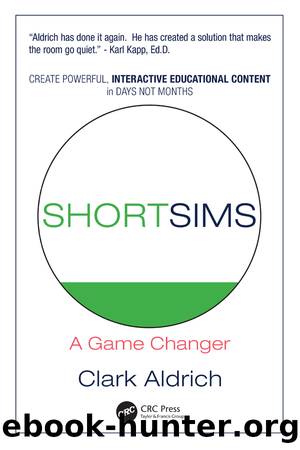Short Sims by Aldrich Clark;

Author:Aldrich, Clark;
Language: eng
Format: epub
Publisher: Taylor & Francis Group
Published: 2020-07-15T00:00:00+00:00
Level Two: The Core Lab
From here, I created the core lab. The user was to have a more open-ended and less chaperoned opportunity to engage the model. Some call this sandbox-mode.
I also had to create a victory condition towards which the player must strive. It could have been something easy and intuitive like “find the price and weather combination that results in the lowest possible demand.” I chose instead to ask the player to find a very specific demand situation, which required a bit more experimentation.
The payoff for the consistent interface allowed the user to not have to focus on it at all. Oddly, many users actually enjoyed the process of repeatedly lowering or raising the price, just to see how the world reacted. This kind of soothing and pleasurable twitch activity, akin to throwing a basketball into a hoop or matching cards in solitaire, is necessary for a great game and certainly a bonus for this type of lab.
Here is a sequence.
Here, the user first raises the price of drinks by 50 cents:
The demand line predictably shrinks from five to four. Then, the user changes the weather (or, to put it in user action terms, waits for the sun to come out) and sees what happens:
The black arrow moves, drawing attention to how the rise in temperature shifts the demand curve to the right. The user can experience that for the same price of $2.00, demand increases from 4 to 6. Some users will toggle the weather button again and again, just to see what happens and draw the appropriate conclusions. For the sake of visually impaired people, I put in brief descriptions that could be read by a screen reader. In this design, it is easier to present the current state (“At $2.00 on a sunny day, demand is six.”) rather than describe the change (“Demand has increased from four to six.”), but one could do both.
Virtually all users, with a bit of strategy and a bit of banging around, find the victory condition of seven people in line. The lab tells them when they are successful.
In our sim, the demand curve serves as a mini-map, akin the map on a driving game, providing a helpful and valued strategic view that aligned with what the player was doing and seeing. Multiple simultaneous views of the same, user-controlled situation help the user discover for themselves about demand curves.
Computer game genres routinely use mini-maps for a strategic view, including the classic Midtown Madness. © Microsoft Corporation
Most users would be upset if the demand curve was taken away, as it would make the activity much harder. This is, of course, the point.
Note: For the effect of dynamic and open-ended interactivity to be achieved in Level 2, 22 PowerPoint slides were created that reflected all possible permutations. The screenshot below (from tool BranchTrack) shows how they were wired, with two columns that matched the two demand curves shown on the chart. From any screen, the user could go up, down, or across, which corresponded with raising or lowering the price, or changing the sun/cloud situation.
Download
This site does not store any files on its server. We only index and link to content provided by other sites. Please contact the content providers to delete copyright contents if any and email us, we'll remove relevant links or contents immediately.
| AI & Machine Learning | Bioinformatics |
| Computer Simulation | Cybernetics |
| Human-Computer Interaction | Information Theory |
| Robotics | Systems Analysis & Design |
Algorithms of the Intelligent Web by Haralambos Marmanis;Dmitry Babenko(7846)
Hadoop in Practice by Alex Holmes(5656)
Jquery UI in Action : Master the concepts Of Jquery UI: A Step By Step Approach by ANMOL GOYAL(5510)
Life 3.0: Being Human in the Age of Artificial Intelligence by Tegmark Max(4496)
Functional Programming in JavaScript by Mantyla Dan(3720)
The Age of Surveillance Capitalism by Shoshana Zuboff(3413)
Big Data Analysis with Python by Ivan Marin(2967)
Blockchain Basics by Daniel Drescher(2884)
The Rosie Effect by Graeme Simsion(2704)
WordPress Plugin Development Cookbook by Yannick Lefebvre(2583)
Hands-On Machine Learning for Algorithmic Trading by Stefan Jansen(2491)
Applied Predictive Modeling by Max Kuhn & Kjell Johnson(2475)
Dawn of the New Everything by Jaron Lanier(2433)
Test-Driven Development with Java by Alan Mellor(2299)
The Art Of Deception by Kevin Mitnick(2295)
Rapid Viz: A New Method for the Rapid Visualization of Ideas by Kurt Hanks & Larry Belliston(2190)
Human Dynamics Research in Smart and Connected Communities by Shih-Lung Shaw & Daniel Sui(2175)
Data Augmentation with Python by Duc Haba(2145)
Once Upon an Algorithm by Martin Erwig(2142)
